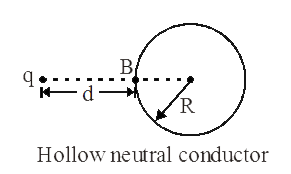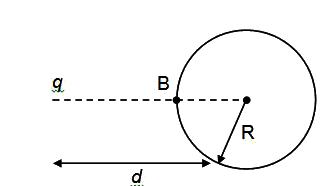For the situation shown in the figure below, mark out the correct statement(s) :

A
Potential of the conductor is q4πε0(d+R)
B
Potential of the conductor is q4πε0d
C
Potential of the conductor can’t be determined as nature of distribution of induced charges is not known
D
Potential at point B due to induced charges is −qR4πε0(d+R)d
Video Solution
Text Solution
The correct Answer is:A, D
Vcentre=Kqd+R=14πe0q(d+R)
Since electric field inside conductor is zero.
dV=¯¯¯E.Overl∈edr
Since E is zero inside conductor
So electric potential at each and every point inside and on the conductor is same.
⇒ Potential of conductor =q4πe0(d+R), Due to induced charge +Vq
V∈ducedchar≥=q4πe0(d+R)−q4πe0d=q4πe0[−R4d(d+R)]=−qR4πe0(d+R)

|
Updated on:21/07/2023
Similar Questions
Knowledge Check
- Question 1 - Select One or More
Mark out the correct statements(s).
AHigher binding energy per nucleon means thenucleus is more stable.BIf the binding energy of nucleus were zero, thenit would spontaneously break apart.CBinding energy of a nucleus can be negativeDBinding energy of a nucleus is always positive - Question 2 - Select One or More
Pick out the correct statement(s)
ASO2 has a bent structureBSO3 has a triangular planar structureCSF4 has a tetrahedral structureDH2S has a bent structure - Question 3 - Select One or More
Pick out the correct statement(s):
AMnO2 dissolves in conc. HCl, but does not form Mn4+ ionsBDecomposition of acidic KMnO4 is not catalysed by sunlightCMnO2−4 is strongly oxidising and stable only in very strong alkalu. In dilute alkali, water or acidic solution it disproportionatesDKMnO4 does not act as oxidising agent in alkaline medium

